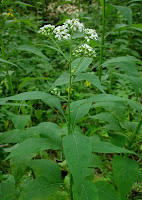 |
| Click to enlarge |
The sassafras trees are bright yellow this time of year, making it easier to find their distinctive leaves. Their most distinctive characteristic are their three leaf shapes. Most leaves are entire but others are one and two fingered mitten shapes as seen to the right.
I have just figured out how to identify sassafras bark. The ridges are rounded between the deep grooves. These ridges resemble my fingers if I hold them together with my palm on the tree pointing up. Just remember the three fingered leaves to remember the bark. Another hint is to slice off the top layer of bark, which will expose the red-brown color beneath.
 Wikipedia lists the use of sassafras as tea, filé powder for gumbo, and an additive in root beer in the past and microbrew beer. Sassafras tea or sassafras oil that contain large doses of safrole have been associated with liver cancer in laboratory animals, leading to an FDA ban on sassafras tea. Sassafras root was one of the earliest new world exports - it was used to perfume soaps and make tea. Native Americans used sassafras trees for dug out canoes.* White-tailed deer consume the leaves and twigs as do many small mammals. The fruits are eaten by many bird species.
Wikipedia lists the use of sassafras as tea, filé powder for gumbo, and an additive in root beer in the past and microbrew beer. Sassafras tea or sassafras oil that contain large doses of safrole have been associated with liver cancer in laboratory animals, leading to an FDA ban on sassafras tea. Sassafras root was one of the earliest new world exports - it was used to perfume soaps and make tea. Native Americans used sassafras trees for dug out canoes.* White-tailed deer consume the leaves and twigs as do many small mammals. The fruits are eaten by many bird species.Most of us think of tea when we hear the word sassafras. Here is what WebMD has to say about it.
"In beverages and candy, sassafras was used in the past to flavor root beer. It was also used as a tea. But sassafras tea contains a lot of safrole, the chemical in sassafras that makes it poisonous. One cup of tea made with 2.5 grams of sassafras contains about 200 mg of safrole. That equates to a dose of about 3 mg of safrole per 1 kg of body weight. This is about 4.5 times the dose that researchers think is poisonous. So, in 1976, the US Food and Drug Administration (FDA) ruled that sassafras could no longer be sold as sassafras tea."
Missouriplants.com has a complete set of pictures.


+-+1.JPG)













